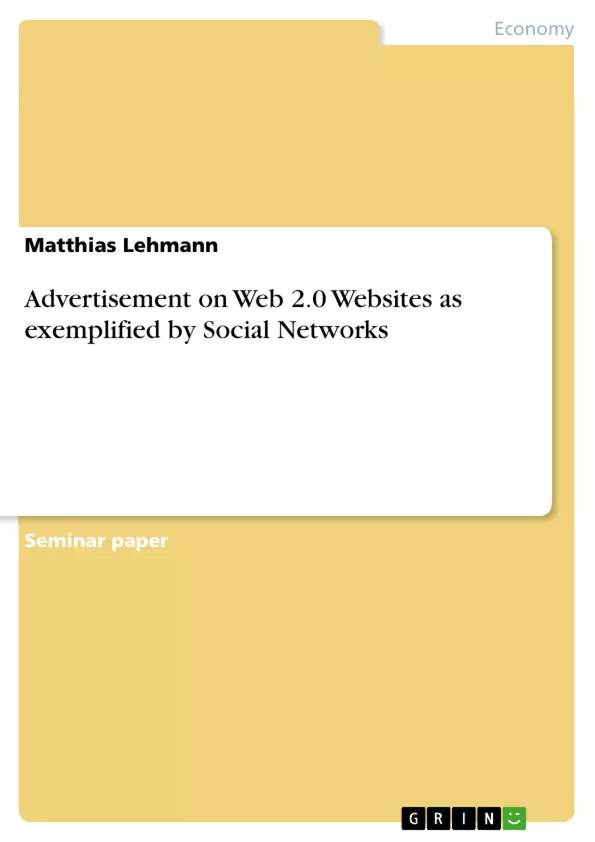The internet is one of the newest communication technologies and has run through fundamental technological progress during the last years. During the end of the 1990's many internet firms
were established whose investors expected high revenues. However many of these platforms could not meet the expectations, the stock prices of many firms declined rapidly and many firms filed for bankruptcy. Since 2004 the internet developed to the Web 2.0 which suggests that a better version
of the web exists today.
Spendings in online advertisements were interestingly not effected by the crash of the internet market at the beginning of the 21st century. Since 1998 the net advertising revenues have increased constantly. In 2008 US-American companies will spend more for internet advertisements than for
TV commercials. In the past, famous Web 2.0 websites were sold for high prices: the Holtzbrinck publishing group bought StudiVZ for around 85 million euros, the video website Youtube was sold
to Google for 1.65 billion dollars and News Corporation paid 580 million dollars for Myspace.
However all of these social networks still have to supply evidence that their company value is not overestimated. As far as the advertisement revenues are concerned none of them generate significant profits yet.
In this paper I will analyze the performance of advertisements on Web 2.0 websites as exemplified by social networks. First I will trace the developments that led to the so-called Web 2.0 and define their characteristics. Then I will focus on social networks, analyze their features and the possibilities
to use them for advertisement purposes. Finally I will analyze several possibilities to advertise on Web 2.0 websites.
Table of Contents
- Introduction
- What is Web 2.0?
- Necessary Developments For Web 2.0.
- The Transfer Rate
- The Access Fees
- The Changes Of User Habits
- The Browser War.
- The Core Competencies Of Web 2.0 Companies
- The Advertisement In Social Networks
- Social Networks.
- Features Of Social Network Websites
- The Status Quo.
- The Performance Of Advertisements
- Framing on Social Network Websites
- Branded Communities.
- Advertisements Designed By Users
- Spread Viral Multimedia Content
- Advertisements In Videos
- Development Of Applications
- Conclusion
Objectives and Key Themes
This paper examines the performance of advertisements on Web 2.0 websites, specifically social networks. The author first explores the key developments that led to the rise of Web 2.0, defining its core characteristics. Next, the focus shifts to social networks, analyzing their features and potential for advertising. Finally, the paper delves into various methods for advertising on Web 2.0 platforms. Key themes of the paper include:- The evolution of Web 2.0 and its characteristics
- The nature and features of social networks
- The role of social networks in digital advertising
- Specific advertising methods within Web 2.0 environments
- The challenges and opportunities for advertising on Web 2.0 websites
Chapter Summaries
The introduction sets the stage for the paper, outlining the growth of the internet and the evolution of advertising within this space. The paper argues that Web 2.0 represents a significant shift in internet development, characterized by factors like increased transfer rates, lower access fees, and evolving user behavior. It highlights the rising value and potential of social networks within this new web landscape.
Chapter 2 focuses on defining Web 2.0, exploring the key developments that led to its emergence. The chapter examines four key areas: transfer rate, access fees, user habits, and browser standardization. The author details the technological advancements that enabled faster internet speeds, lower access costs, and the growth of user knowledge and trust. The chapter also explores the impact of the "browser war" on the development of Web 2.0, emphasizing the shift towards standardization and increased ease of website development.
Chapter 3 delves into the realm of social networks, exploring their characteristics and potential for advertising. The chapter examines the features that define social networks, including user interaction, content sharing, and community building. The paper analyzes the performance of advertisements on social networks, highlighting the challenges and opportunities of this space. Finally, the chapter outlines various advertising methods within social networks, such as branded communities, user-generated content, viral marketing, and video advertising.
Keywords
This paper focuses on the analysis of Web 2.0, social networks, digital advertising, social media marketing, branding, user-generated content, viral marketing, and the impact of internet technology on user behavior and business models.- Quote paper
- Matthias Lehmann (Author), 2008, Advertisement on Web 2.0 Websites as exemplified by Social Networks, Munich, GRIN Verlag, https://www.grin.com/document/140299



